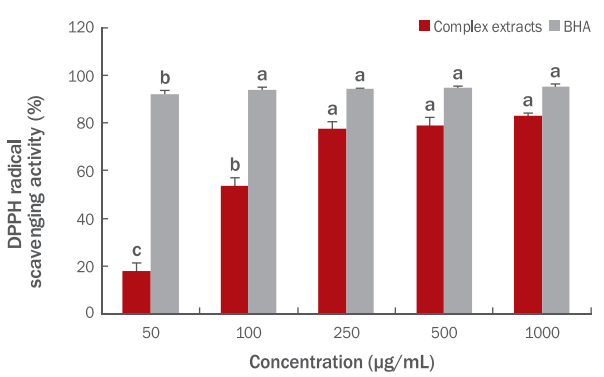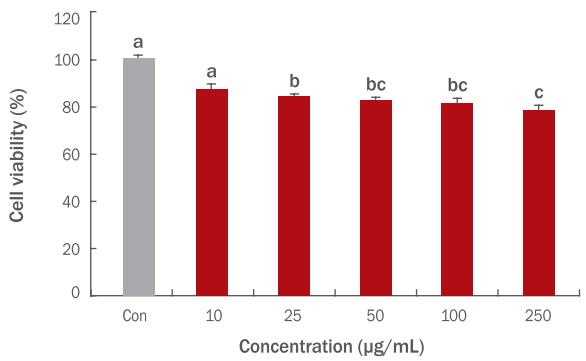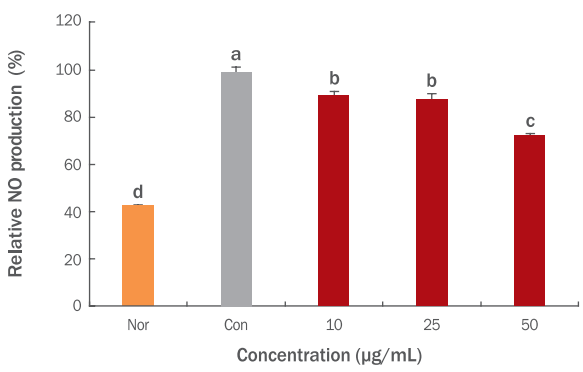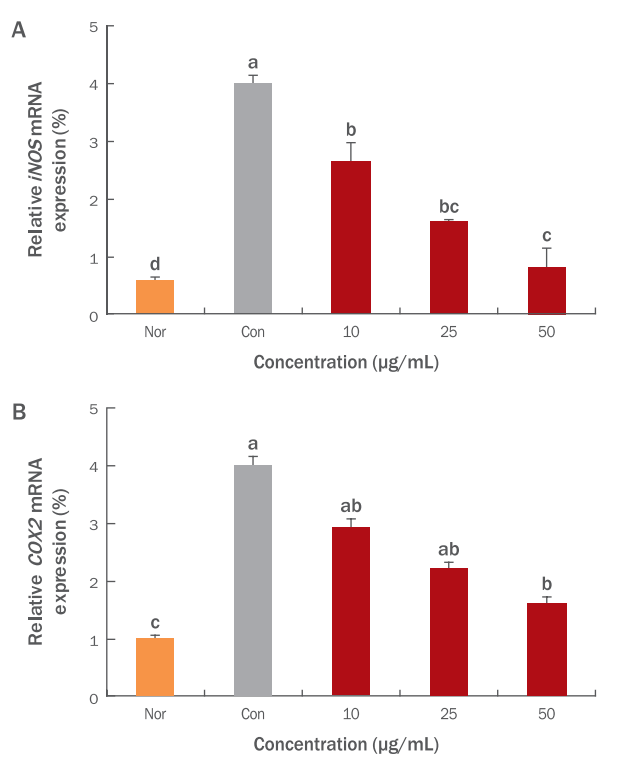블루베리, 상황, 율피, 승마 복합추출물의 화장품 소재로서의 효능
Efficacy of a Cosmetic Material from Complex Extracts of Vaccinium spp., Phellinus linteus, Castanea crenata, and Cimicifuga heracleifolia
蓝莓、桑黄、栗皮、升麻复合提取物作为化妆品原料的功效
Article information
Abstract
목적
본 연구에서는 블루베리, 상황, 율피, 승마 복합추출물의 화장품 소재로서의 가능성을 확인하기 위해 항산화와 항염증 활성을 측정하였다.
방법
블루베리, 상황, 율피, 승마는 70% 에탄올에서 추출하였고, 복합추출물은 각 시료를 1:1:1:1의 비율로 사용하였다. 항산화 평가를 위해 복합물을 농도에 따라 처리하여 1,1-diphenyl-2-picrylhydrazyl (DPPH) 라디칼 소거능과 2,2’-azino-bis (3-ethylbenzothiazoline-6-sulphonic acid) (ABTS) 양이온 라디칼 소거능을 확인하였다. 항염증 활성평가는 과학적으로 증명된 방법인 3-(4,5-dimethylthiazol-2-yl)-2,5-diphenyltetrazolium bromide (MTT) 분석법, western blot 분석법, realtime polymerase chain reaction (real-time PCR) 분석법으로 측정하였다.
결과
복합추출물은 1000 µg/mL 농도에서 DPPH 라디칼 소거능 활성이 83.1%로 나타났으며 ABTS+ 라디칼 소거능 활성이 98.4%로 나타났다. MTT 분석법을 통한 세포 생존율은 10, 25, 50 µg/mL 농도에서는 생존율이 81.0% 이상으로 나타났고, 100, 250 µg/mL 농도에서는 세포사멸이 21.0% 이상으로 나타났다. 따라서 복합물의 최종농도를 10–50 µg/mL로 사용하였다. Nitric oxide (NO) 생성은 50 µg/mL 농도에서 28.0% 감소되었고, western blot 분석을 통한 inducible nitric oxide synthase (iNOS)와 cyclooxygenase 2 (COX2) 단백질 발현은 50 μg/mL 농도에서 각 32.8%, 48.0%의 감소를 나타내었다. Real-time PCR 결과 iNOS와 COX2의 mRNA 발현율은 농도 의존적으로 감소되었다.
결론
복합추출물은 항산화 및 항염증에 탁월한 효능이 있으며 이러한 추출물이 향후 약용화장품 소재로서 사용되기를 기대한다.
Trans Abstract
Purpose
To confirm the possibility of using complex extracts of Vaccinium spp., Phellinus linteus, Castanea crenata, and Cimicifuga heracleifolia for cosmetic substances, we tested anti-oxidant and anti-inflammatory activities.
Methods
The complex extracts of Vaccinium spp., Phellinus linteus, Castanea crenata, and Cimicifuga heracleifolia were used in a ratio of 1:1:1:1, and these complexes were extracted in 70% ethanol. To evaluate the anti-oxidant activity, the complexes were concentrated and the scavenging activities of the 1,1-diphenyl-2-picrylhydrazyl (DPPH) radical and 2,2’-azino-bis (3-ethylbenzothiazoline-6-sulphonic acid) (ABTS) cation were assessed. The anti-inflammatory activity was measured using the 3-(4,5-dimethylthiazol-2-yl)-2,5-diphenyltetrazolium bromide (MTT) assay, western blot analysis, and real-time polymerase chain reaction (real-time PCR).
Results
Complex extracts showed 83.1% DPPH and 98.4% ABTS+ radical scavenging activities at a concentration of 1000 µg/mL. The MTT assay revealed cell viability over 81.0% at 10, 25, and 50 µg/mL concentrations of the complex extracts and cell death over 21.0% at 100 and 250 μg/mL concentrations of the complex extracts. Therefore, the experimental concentration of the complex extracts was 10–50 μg/mL. Western blot analysis revealed that at 50 µg/mL concentration of the complex extracts, the expression level of nitric oxide (NO) was decreased by 28.0% and those of inducible nitric oxide synthase (iNOS) and cyclooxygenase 2 (COX2) were decreased by 32.8% and 48.0%, respectively. Real-time PCR showed a decrease in iNOS and COX2 mRNA expression levels in a concentration-dependent manner.
Conclusion
Complex extracts have excellent anti-oxidant and anti-inflammatory effects, and we expect that these extracts will serve as functional cosmeceutical materials.
Trans Abstract
目的
探讨蓝莓、桑黄、栗皮、升麻复合提取物作为化妆品原料的可行性, 测定其抗氧化和抗炎活性。
方法
在70%乙醇中, 分别提取蓝莓、桑黄、栗皮、升麻的提取物, 将这些提取物按1:1:1:1的比例混合作为复合提取物。为了评价复合提取物的抗氧化活性检测1,1-diphenyl-2-picrylhydrazyl (DPPH) 自由基消除能力和2,2’-azino-bis (3-ethylbenzothiazoline-6-sulphonic acid) (ABTS) 阳离子消除能力。抗炎症活性通过科学证明的方法, 即, 3-(4,5-dimethylthiazol-2-yl)-2,5-diphenyltetrazolium bromide (MTT) 分析法、western blot法、real-time polymerase chain reaction (real-time PCR) 等方法来评价。
结果
1000 μg/mL的复合提取物的DPPH自由基消除能力为83.1%, ABTS+自由基消除能力为98.4%。细胞生存率通过MTT分析法来测定, 在10, 25, 50 μg/mL的浓度下, 细胞生存率显示出81.0%以上, 在100, 250 μg/mL的浓度下, 细胞死亡达到21.0%以上。因此, 复合提取物的最终使用浓度为10–50 μg/mL。在50 μg/mL浓度下, nitric oxide (NO) 的生成减少了28.0%。通过western blot法检测inducible nitric oxide synthase (iNOS) 和cyclooxygenase 2 (COX2) 的蛋白质表达, 其结果显示:复合提取物在50 μg/mL浓度下, iNOS和COX2分别减少了32.8%, 48.0%。Real-time PCR结果显示:iNOS和COX2的mRNA表达水平以浓度依赖性降低。
结论
复合提取物具有卓越的抗氧化和抗炎症功效, 期待这些提取物将成为药妆品使用。
Introduction
피부는 자외선, 독성물질, 기계적인 손상 등 외부환경으로부터 신체를 보호하고 내부 체액의 소실을 막는 장벽기능을 하는 중요한 기관이다(Boelsma et al., 2001; Hwang et al., 2006). 그러나 현대인들은 정신적인 스트레스, 환경오염, 불규칙적인 식습관 및 수면부족 등의 여러 가지 요인들로 인해, 피부장벽의 기능이 제 역할을 하지 못하여 조기노화, 피부건조증, 만성 염증성 질환 등을 겪고 있다(Kim et al., 2009; Whang et al., 2010). 이러한 피부질환을 비롯한 대부분의 질병에는 활성산소가 관여하고 있는데 이는 피부항산화제 파괴, 지질과산화 반응의 개시, 단백질 및 DNA의 산화에 영향을 미칠 뿐만 아니라, 콜라겐, 엘라스틴 결합조직의 사슬을 절단하여 주름을 생성시키고, 멜라닌의 생성을 증가시킨다(Ko, 2012; Park, 2003).
현대 과학자들은 인체의 산화를 지연시켜 건강하고 아름다운 피부를 유지하기 위해 superoxide anion radical (O2-), hydroxyl radical (OH-), singlet oxygen (1O2) 및 hydrogen peroxide (H2O2)와 같은 활성산소를 제거하기 위한 연구를 끊임없이 하고 있다(Imlay & Linn, 1988; McCord, 1987). 대부분의 식물들은 이러한 활성산소에 대한 방어기전을 가지고 있으며 식물에서 항산화 활성을 나타내는 물질로는 flavonoids, anthocyanins, carotenoids, vitamin 및 essential oil 등이 있으며 효소계 항산화제는 superoxide dismutase, catalase, glutathione peroxidase 등이 있다(Hertog et al., 1993).
합성 항산화제로는 α-tocopherol, β-carotene, ascorbic acid, butylated hydroxyanisole (BHA), butylated hydroxytoluene (BHT) 및 nordihydroguaiaretic acid (NDGA)와 같은 물질이 라디칼 소거제로 알려져 있으며 널리 쓰이고 있다(Han, 2006). 이러한 합성 항산화제는 효과가 뛰어난 반면에 과량 투여할 경우, 간, 위장 점막, 폐, 신장, 순환계통에 심각한 부작용을 유발하는 것으로 알려져 있어 사용량을 규제하고 있는 실정이다(Shin, 1984). 따라서 천연물 유래의 보다 안전하고 뛰어난 효과를 가지는 화합물에 관한 연구가 활발하게 수행되고 있다.
해로운 주위환경 및 외부의 물리적, 화학적 자극으로부터 생체를 보호하는 생리적 반응인 염증은 대식세포(macrophage)에서 과량 생산되는 염증 매개인자(inflammatory mediators)를 통해 중개되는데, NO 및 prostaglandin E2 (PGE2) 등과 같은 염증인자는 iNOS 및 COX2에 의해 형성된다(Kim et al., 2009; Kundu & Surh, 2012). NO synthase에는 neuronal NOS (nNOS), endothelial NOS (eNOS), 그리고 iNOS가 있는데 일반적으로 생체 내에서 혈관확장에 관여하여 혈압을 조절하고, 세포 간 혹은 세포 내 신호전달 및 항균작용 등과 같은 다양한 역할을 한다고 알려져 있다(Hippeli & Elstner, 1999; McCartney-Francis et al., 1993). 이 중 iNOS에 의한 NO 생성이 절대적으로 많으며, 과도하게 생성되면 인체에 유해한 영향을 미치게 되어 염증반응 및 세포손상 뿐만 아니라 뇌막염, 알츠하이머병과 파킨슨병 같은 퇴행성질환의 중요한 발생요인으로 작용하는 것으로 알려져 있다(Lowenstein & Snyder, 1992). 한편, 다른 염증인자인 PGE2 를 생성하는 COX는 arachidonic acid를 prostaglandins로 전환하는 효소로 cyclooxygenase 1 (COX1)과 COX2로 나뉘어지는데, 이는 다양한 세포에서 다른 발현 경향을 나타낸다. COX1은 정상적인 생체 기능에 작용하지만, COX2는 염증반응 부위에서 발현된다(Masferrer et al., 1994). 따라서 iNOS와 COX2의 발현을 억제하는 물질은 잠재적으로 유용한 항염증제로서의 개발가능성이 높게 평가된다(Hseu et al., 2005; Surh et al., 2001).
화장품은 피부에 일상적으로 사용되나, 다양한 환경인자와 스트레스로 인해 피부트러블을 일으킬 수 있으므로 자연친화적인 것을 추구하는 경향이 있다(Kim et al., 2012). 이에 따라 식물유래 천연물의 유용성을 기반으로 한 여러 가지 원료가 화장품에 배합되고 있다(Park et al., 2008). 화장품에 사용되는 천연물 소재는 단일추출물 보다는 피부에 유효성이 있는 다양한 추출물이 배합되어 사용되고 있으며 실제 천연물의 혼합을 통한 상호작용으로 인해 항산화 효과가 상승된다는 연구가 보고된 바 있다(Huang et al., 2005). 따라서 본 연구에서는 블루베리, 상황, 율피, 승마 복합추출물을 통해 화장품 기능성 소재로서의 효과를 검증하고자 시료를 70% 에탄올 추출한 후 혼합하여 항산화 실험을 하였고 항염증 활성을 확인하기 위하여 대식세포인 Raw 264.7 cell을 통해 lipopolysaccharide (LPS)를 처리하여 혼합물의 효능을 확인하였다.
Methods
1. 추출물의 제조
블루베리, 상황, 율피, 승마는 건조하여 파쇄한 후 70% 에탄올을 용매로 하여 시료중량의 10배 양을 가하여 실온에서 24 h 침지하고 상층액과 침전물을 분리하여 동일한 방법으로 3회 반복 추출하였다. 개별 시료를 원심 분리 및 여과한 다음, rotary vacuum evaporator (HS-10SP; Hahnshin S&T, Korea)를 사용하여 농축한 후 동결기(FD5525; Ilshin BioBase, Korea)로 건조하였다. 건조한 시료는 냉장실에 보관하여 사용할 때마다 1:1:1:1의 동일비율로 혼합하여 사용하였다.
2. DPPH 라디칼 소거능 측정
추출물의 DPPH 라디칼 소거능은 다음과 같이 측정하였다. 시료와 양성대조군 BHA (Sigma-Aldrich, USA) 각 100 μL에 0.2 mM의 DPPH (Sigma-Aldrich) 50 μL를 넣어 최종농도를 50, 100, 250, 500, 1000 μg/mL로 만들어 교반한 후 30 min 방치한 다음 enzyme-linked immunosorbent assay (ELISA) reader (PowerWave™ XS Microplate Spectrophotometer; BioTek Instruments, USA)를 이용해 517 nm에서 흡광도를 측정하였다. 전자공여능 효과는 시료용액의 첨가구와 무첨가구의 흡광도 감소율로 나타내었다.
3. ABTS+ 라디칼 소거능 측정
ABTS+ 라디칼 소거능 측정은 7 mM ABTS (Sigma-Aldrich)와 2.4 mM potassium persulfate (K2S2O8; Sigma-Aldrich)를 1:1로 혼합하여 암실 및 실온에서 24 h 동안 반응시킨 후, 사용 전에 ABTS 용액을 에탄올에 희석하여 734 nm에서 흡광도 값이 0.706±0.001이 되게 하여 사용하였다. 시료와 양성대조군 BHT 각 50 μL에 ABTS와 potassium sulfate 혼합액 950 μL를 첨가하여 최종농도를 50, 100, 250, 500, 1000 μg/mL로 만든 후 734 nm에서 흡광도를 측정하였다.
4. 세포독성 측정
본 연구에서 사용된 Raw 264.7 세포(murine macrophage cell line)는 한국세포주은행(Korean Cell Line Bank, Korea)에서 구입하여 사용하였다. Raw 264.7 세포의 배양은 10% fetal bovine serum (FBS; Introgen Therapeutics, USA)과 1% penicillin/streptomycin (Hyclone™, GE Healthcare Life Sciences, UK) 100 U/mL을 첨가한 Dulbecco’s modified Eagle medium (DMEM; Gibco™, Thermo Fisher Scientific, USA) 배지를 사용하였으며, 37℃, 5% CO2 incubator (Forma™, Thermo Fisher Scientific)에 적응시켜 계대 배양하였다. 세포생존율 측정은 다음과 같이 측정하였다. Raw 264.7 세포를 96 well plate에 well당 0.6×105 세포로 180 μL 분주하고, 37℃, 5% CO2 incubator에서 24 h 배양하였다. 배양 후 복합추출물의 최종농도가 10, 25, 50, 100, 250 μg/mL이 되도록 각각 20 μL씩 첨가한 후 24 h 배양하였다. 대조군은 시료와 동량의 증류수를 첨가하여 동일한 조건으로 배양하였다. 배양 후 각 well에 5 mg/mL 농도로 제조한 MTT (Sigma-Aldrich) 용액 20 μL를 첨가하여 4 h 배양한 후 배양액을 제거하고 dimethyl sulfoxide (DMSO; Sigma-Aldrich)와 에탄올을 1:1로 섞은 용액을 각 well당 150 μL를 가하여 실온에서 30 min 동안 반응시킨 뒤 ELISA reader로 550 nm에서 흡광도를 측정하였다. 세포생존율 측정은 시료용액의 첨가군와 무첨가군의 흡광도 감소율로 나타내었다.
5. NO 생성 저해능 측정
Raw 264.7 세포를 6 well plate에 1×105 cells/mL로 24 h 배양하였다. 다음날 세포 밀도가 80% 되었을 때, phosphate buffered saline (PBS; Sigma-Aldrich)으로 2번 세척한 후 무혈청 배지를 사용하여 24 h 배양한 후 1 µg/mL LPS (Sigma-Aldrich)를 Normal군을 뺀 모든 well에 넣어서 자극시켰다. 2 h 후에 복합추출물(10, 25, 50 μg/mL)을 처리하고 24 h 후에 상층액 100 µL와 Griess reagent (Sigma-Aldrich) 100 µL를 1:1로 10 min 동안 반응시킨 후에 ELISA reader로 540 nm에서 흡광도를 측정하여 NO 생성량을 확인하였다.
6. Western blot
Raw 264.7 세포를 6 well plate에 1×105 cells/mL의 농도로 접종 및 배양하여 세포 밀도가 80% 되었을 때 무혈청 배지로 교환하고 24 h 배양한 후 LPS (1 µg/mL)를 Normal 군을 뺀 모든 well에 넣어서 자극시켰다. 2 h 후에 복합추출물(10, 25, 50 μg/mL)을 처리하고 24 h 배양하였다. 그 후 상층액을 제거하고 PBS로 2회 세척한 후에 scrapper로 세포를 수확하고 lysis buffer [radioimmunoprecipitation assay (RIPA) buffer; Sigma-Aldrich]를 넣어서 용출시켰다. 수확된 단백질은 bovine serum albumin (BSA; Sigma-Aldrich)로 작성한 표준 곡선을 통해 단백질량을 보정하였다. 그 후에 brilliant blue R staining solution (coomassie blue; Sigma-Aldrich)로 염색하여 재보정한 후에 western blot 시료로 사용하였다. 12% Acrylamide gel에 샘플을 주입하여 전기영동을 실시한 후 nitrocellulose membrane (Amersham™, GE Healthcare Life Sciences)에 이동시켰다. 그 후 blocking solution [5% skim milk in mixture of tris-buffered saline and tween 20 (TBST) buffer]을 이용해 24 h 동안 blocking 하였다. 그런 다음 1차 antibody (anti-mouse iNOS, anti-mouse COX2, anti-mouse ACTB; Santa Cruz Biotechnology, USA)를 3 h 각각 반응시킨 후 horseradish peroxidase (HRP)가 결합된 2차 antibody (anti-mouse IgG; Santa Cruz Biotechnology)를 1:1000으로 희석하여 1 h 반응시켰다. TBST로 3회 세척한 후에 enhanced chemiluminescence (ECL) kit (Amersham™)를 사용하여, ECL 기질(Amersham™)과 1 min 반응 후 Chemiluminescent Imaging System (LuminoGraph; ATTO, Japan)을 이용해서 단백질 발현량을 확인하였다.
7. Real-time PCR
Raw 264.7 세포를 100 mm dish에 1×105 cells/mL의 농도로 접종한 다음 24 h 동안 배양 후 무혈청 배지로 안정화시킨 후 LPS (1 µg/mL)를 Normal 군을 뺀 모든 well에 넣어서 자극시켰다. 2 h 후에 복합추출물(10, 25, 50 μg/mL)을 처리하고 24 h 배양하였다. 그 후 배지 상층액을 제거하고 TRI Reagent® (Sigma-Aldrich)를 각 well에 1 mL씩 분주하여 세포를 용해하여 포집한 다음 8000 rpm에서 1 min 동안 원심 분리하였다. Chloroform (Sigma-Aldrich) 200 μL를 분주하여 20 s 동안 혼합한 후 13000 rpm에서 2 min 동안 원심 분리하여 상층액을 500 μL isopropanol (Sigma-Aldrich)이 들어있는 튜브에 옮겨 섞었다. 다시 13000 rpm에서 15 min 동안 원심 분리하였고, 그 상층액을 제거한 후 70% 에탄올을 각 튜브에 1 mL씩 분주하여 13000 rpm에서 5 min 동안 원심 분리한 뒤 상층액을 제거하고 실온에서 건조시켰다. RNA 5 μL에 0.1% diethyl pyrocarbonate (DEPC; Sigma-Aldrich)를 955 μL를 첨가하여 260 nm, 280 nm에서 각각 흡광도를 측정하여 total RNA 양을 측정하였다. cDNA 합성은 Transcriptor First Strand cDNA Synthesis Kit (Roche Diagnostics, Switzerland)를 이용해 다음과 같이 합성하였다. Oligo (dT) primer (500 μg/mL) 1 μL, RNase free water 10 μL, 추출한 RNA (2 μg)를 넣고 25℃에서 10 min 반응 후, Transcriptor RT reaction buffer 4 μL, Protector RNase inhibitor 0.5 μL, Deoxynucleotide mix 2 μL, Transcriptor reverse transcriptase 0.5 μL를 첨가하여 55℃에서 30 min, 85℃에서 5 min, 4℃에서 1 h 반응시켜 cDNA를 합성하였다. Real-time PCR (FastStart Essential DNA Green Master Kit; Roche Diagnostics)을 이용해서 희석한 cDNA 2 μL와 SYBR green 10 μL, primer 1 μL를 각각 넣어 PCR (LightCyber® Nano Real-Time PCR System; Roche Diagnostics) 기기를 이용하여 실시간 정량분석을 한 뒤 결과를 분석하였다.
8. 통계처리
통계처리 실험결과에 대한 통계처리는 Statistical Package for the Social Sciences (SPSS) software package (Version 22.0; IBM, USA)를 이용하여 평균과 표준편차로 나타내었고, 각 처리군 간의 유의성에 대한 검증은 analysis of variance (ANOVA)를 이용하여 유의성을 확인한 후, p<0.05 수준에서 Duncan’s multiple test를 이용하여 분석하였다.
Results and Discussion
1. DPPH 라디칼 소거활성
DPPH 라디칼 소거활성법은 비교적 안정한 자유라디칼(free radical)인 DPPH에 항산화 물질을 처리할 경우, 항산화 물질의 전자공여로 DPPH 라디칼이 환원되어 짙은 보라색이 탈색되는 정도를 통해 항산화 효능을 측정하는 방법이다(Park & Lee, 2013). 블루베리, 상황, 율피, 승마 복합추출물과 양성대조군으로 사용된 BHA의 DPPH 라디칼 소거능을 측정한 결과는 Figure 1과 같이 나타났다. 실험 결과, 대조군의 활성이 복합추출물 대비 높았으며 복합추출물은 농도가 높아질수록 유의적으로 활성이 증가하였으며 500 µg/mL 농도에서 79.0%, 1000 µg/mL 농도에서 83.1%의 높은 항산화능을 나타내었다. 한방화장품 소재개발을 위한 Lee & Kim (2015)의 연구에서는 당귀, 천궁, 작약, 지황, 황금 혼합추출물의 DPPH 라디칼 소거능 실험 결과 500 µg/mL 농도에서 60.0%의 활성을 나타낸 것과 비교할 때 블루베리, 상황, 율피, 승마 복합추출물이 더 높은 활성을 나타내었다.

DPPH radical scavenging activity of complex extracts.
DPPH radical scavenging activity of the complex extracts increased in a concentration-dependent manner. The results are presented as M±SD of triplicate data. The superscripts (a–c) within the same column indicate that they are significantly different at p<0.05, as assessed using Duncan’s multiple range test. Complex extracts, Vaccinium spp., Phellinus linteus, Castanea crenata, and Cimicifuga heracleifolia at a ratio of 1:1:1:1; DPPH, 1,1-diphenyl-2-picrylhydrazyl; BHA, butylated hydroxyanisole, used as a positive control; M±SD, mean±standard deviation.
2. ABTS+ 라디칼 소거활성
ABTS+ 라디칼 소거 활성법은 in vitro, in vivo 항산화능 측정에 널리 이용되고 있다. ABTS를 peroxidase, H2O2와 반응시켜 활성 양이온인 ABTS+ 자유라디칼이 형성되면 추출물의 항산화력에 의해 ABTS+ 자유라디칼이 소거되어 라디칼 특유의 색인 청록색이 탈색되는데 이를 흡광도 수치로 나타내어 추출물의 항산화 활성을 평가할 수 있다(Prior et al., 2005). ABTS+ 라디칼 소거능의 경우 hydrogen donating antioxidants와 chain breaking antioxidants 를 모두 측정할 수 있고, 친수성 물질과 소수성 물질의 항산화력 측정이 가능하므로 일반적으로 DPPH 라디칼 소거능 보다는 높은 활성을 나타낸다(Re et al., 1999). 본 실험결과에서도 ABTS+ 라디칼 소거능을 측정한 결과는 DPPH radical 소거능 결과에 대비하여 항산화능이 높게 나타났다(Figure 2). 복합추출물의 500 µg/mL 농도에서 95.6%로 동일농도에서 BHT (94.5%)와 유사한 효능을 나타냈고, 1000 µg/ml 농도에는 98.4%로 합성 항산화제로 널리 쓰이고 있는 BHT (96.9%)에 비해서 우수한 효능을 나타내었다. Kim et al. (2014)의 연구에서 애기달맞이 꽃, 상황버섯과 감초추출물을 혼합한 화장품 소재의 ABTS+ 라디칼 소거능이 500 µg/mL 농도에서 95.0%로 유사한 효능을 나타내어 본 연구에서 사용된 복합추출물의 항산화 효과와 유사함을 나타내었다. 이러한 결과로 볼 때 복합 추출물은 활성산소로부터 발생되는 노화 및 세포 손상 등을 방지할 수 있는 화장품 소재로 이용 가능성이 있음을 확인하였다.

ABTS+ radical scavenging activity of complex extracts.
ABTS+ radical scavenging activity of the complex extracts increased in a concentration-dependent manner. Results are presented as M±SD of triplicate data. The superscripts (a–d) within the same column mean that they are significantly different at p<0.05, as assessed using Duncan’s multiple range test. Complex extracts, Vaccinium spp., Phellinus linteus, Castanea crenata, and Cimicifuga heracleifolia at a ratio of 1:1:1:1; ABTS, 2,2′-azinobis (3-ethylbenzothiazoline-6-sulphonic acid); BHT, butylated hydroxytoluene, used as a positive control; M±SD, mean±standard deviation.
3. 세포생존율
세포독성을 확인하기 위한 MTT 검색법은 96 well plate를 사용하며, ELISA reader를 이용하면 많은 시료를 간단하게 판독할 수 있어 세포독성 및 세포증식 검색법으로서 널리 사용되고 있는 방법 중 하나이다. 복합추출물에 의한 macrophage인 Raw 264.7 세포의 독성을 MTT assay에 의해 확인한 결과는 Figure 3과 같이 나타내었다. 복합추출물을 10, 25, 50, 100, 250 μg/mL의 농도로 처리하여 세포생존율을 측정하였으며 100 µg/mL 이상의 농도에서 세포생존율이 80% 이하로 나타나 세포독성에 낮은 농도인 10, 25, 50 µg/mL 농도에서 이후 실험을 진행하였다.

Cell viability of complex extracts in RAW 264.7 cells.
RAW 264.7 cells were treated with various concentrations (10– 250 μg/mL) of complex extracts. Cell viability was measured using the MTT assay and was found to be over 81.0% at 10–50 µg/mL concentrations of the complex extracts. Cell death was over 21.0% at 100–250 μg/mL concentrations of the complex extracts. The results are presented as M±SD of triplicate data. The superscripts (a–c) within the same column mean that they are significantly different at p<0.05, as assessed using Duncan’s multiple range test. Complex extracts, Vaccinium spp., Phellinus linteus, Castanea crenata, and Cimicifuga heracleifolia at a ratio of 1:1:1:1; MTT, 3-(4,5-dimethylthiazol-2-yl)-2,5-diphenyltetrazolium bromide; Con, complex extracts-untreated group; M±SD, mean±standard deviation.
4. NO 생성 저해활성
복합추출물의 효과를 확인하기 위해 NO 생성 저해활성을 측정한 결과는 Figure 4와 같다. NO는 아질산염을 측정하는 Griess reagent를 이용해 간접적으로 측정할 수 있으며, 염증반응 부위에서 NO의 과다발현은 많은 염증과 자가 면역질환의 매개물질로 작용한다(Southan & Szabó, 1996). LPS를 1 μg/mL 농도로 처리한 군을 100% (Control)로 두고 LPS를 처리하지 않은 군(Normal)은 41.0%의 낮은 NO 값을 나타내었고 복합물을 10, 25, 50 μg/mL 처리했을 때 각 농도별로 90.6%, 88.4%, 72.0%로 NO 발현량이 낮아지는 것을 확인하였다.

Inhibitory effects of complex extracts on NO production.
To confirm the inhibitory effects of complex extracts on NO production, RAW 264.7 cells (1×105 cells/mL) were treated with 1 µg/mL LPS for 2 h, except Nor group. Complex extracts were then added to sample groups with the indicated concentrations. NO production of the complex extracts decreased in a concentration-dependent manner. The results are presented as M±SD of triplicate data. The superscripts (a–d) within the same column mean that they are significantly different at p<0.05, as assessed using Duncan’s multiple range test. Complex extracts, Vaccinium spp., Phellinus linteus, Castanea crenata, and Cimicifuga heracleifolia at a ratio of 1:1:1:1; NO, nitric oxide; LPS, lipopolysaccharide; Nor, normal group (LPS-untreated group); Con, control group (LPS-treated group); M±SD, mean±standard deviation.
5. iNOS, COX2 단백질 발현 저해활성
염증관련 단백질인 iNOS, COX2의 발현량을 알아보기 위해 western blot을 실시한 결과는 Figure 5와 같다. 세포만 단독 배양한 무처리군에서는 iNOS, COX2 단백질 발현이 약하나 LPS를 1 μg/mL 농도로 처리한 군은 무처리군에 비해 발현량이 현저히 증가하였다. 복합추출물 처리군은 염증 발현 유도물질인 LPS 처리군과 비교해 보았을 때 iNOS의 경우 50 μg/mL 농도에서 32.8% 이상의 높은 발현 억제효과를 나타냄을 확인할 수 있었으며, COX2의 경우 동일농도에서 48.0%의 발현 억제효과를 나타냈다. 복합물에 의한 iNOS 단백질 발현 억제는 NO 생성 저해활성과 유사한 경향을 나타내어 NO 생성 저해가 iNOS 단백질 발현 저해를 경유한 것임을 알 수 있었다.

Inhibitory effects of complex extracts on inflammation-related protein expression in RAW 264.7 cells.
Expression of inflammation-related proteins such as iNOS and COX2 was confirmed by western blot (A). Their expression was compared with ACTB and expressed as a percentage, as indicated by bar graphs (B, C). RAW 264.7 cells (1×105 cells/mL) were treated with 1 µg/mL LPS for 2 h, except Nor group. Complex extracts were then added to sample groups with the indicated concentrations. The relative expressions of iNOS and COX2 were decreased by 32.8% and 48.0% at 50 µg/mL concentration of the complex extracts, respectively. The results are presented as M±SD of triplicate data. The superscripts (a–e) within the same column mean that they are significantly different at p<0.05, as assessed using Duncan’s multiple range test. Complex extracts, Vaccinium spp., Phellinus linteus, Castanea crenata, and Cimicifuga heracleifolia at a ratio of 1:1:1:1; LPS, lipopolysaccharide; iNOS, inducible nitric oxide synthase; COX2, cyclooxygenase 2; ACTB, actin beta; Nor, normal group (LPS-untreated group); Con, control group (LPS-treated group); M±SD, mean±standard deviation.
6. iNOS, COX2의 mRNA 발현측정
항염 효능과 관련하여 복합추출물이 mRNA 발현에 미치는 영향을 알아보기 위하여 Raw 264.7 세포에 10, 25, 50 μg/mL의 농도로 처리하여 iNOS, COX2의 mRNA 발현량을 real-time PCR로 측정하였다. 그 결과 Figure 6에서 보는 바와 같이 세포만 단독 배양한 무처리군에서는 iNOS, COX2 mRNA 발현이 약하나 LPS를 1 μg/mL 농도로 처리한 군은 무처리군에 비해 mRNA 발현이 현저히 증가하였다. 또한 복합물을 처리하였을 때 농도가 증가함에 따라 iNOS, COX2의 mRNA 발현이 감소되는 것을 확인할 수 있었다. 이상의 결과를 종합하여 볼 때, 복합추출물은 LPS로 유도된 대식 세포 내 염증발현을 mRNA 수준에서 iNOS, COX2의 발현을 억제하고 iNOS와 COX2 단백질의 활성억제를 통해 NO 생산을 억제하는 것을 확인하였다.

Inhibitory effects of complex extracts on the mRNA expression of inflammation-related proteins in RAW 264.7 cells.
Effects of complex extracts on the mRNA expression of iNOS and COX2 were confirmed using real-time PCR in RAW 264.7 cells (A, B). RAW 264.7 cells (1×105 cells/mL) were treated with 1 µg/mL LPS for 2 h, except Nor group. Complex extracts were then added to sample groups with the indicated concentrations. The results showed that the relative iNOS and COX2 mRNA expressions decreased in a concentration-dependent manner. The results are presented as M±SD of triplicate data. The superscripts (a–d) within the same column mean that they are significantly different at p<0.05, as assessed using Duncan’s multiple range test. Complex extracts, Vaccinium spp., Phellinus linteus, Castanea crenata, and Cimicifuga heracleifolia at a ratio of 1:1:1:1; iNOS, inducible nitric oxide synthase; COX2, cyclooxygenase 2; Real-time PCR, real-time polymerase chain reaction; LPS, lipopolysaccharide; Nor, normal group (LPS-untreated group); Con, control group (LPS-treated group); M±SD, mean±standard deviation.
Conclusion
건강하고 아름다운 피부에 대한 관심이 증가함에 따라 천연 약용식물 추출물로부터 화장품 소재를 개발하기 위한 연구가 활발히 진행되고 있다(Kim et al., 1995; Lim et al., 1996). 특히 항산화, 항염증, 미백의 활성을 보유한 기능성 소재 개발에는 피부에 독성이 없으며 유효성이 높은 물질 개발이 주를 이루고 있다(Lee et al., 2014). 본 연구에서는 블루베리, 상황, 율피, 승마 복합추출물의 항산화, 항염증 실험을 통해 화장품 소재로서의 가능성에 대해 평가하였으며 다음과 같은 결론을 얻었다.
첫째, 항산화 평가에서 복합물은 1000 µg/mL 농도에서 DPPH 라디칼 소거능은 83.1%, ABTS+ 라디칼 소거능은 98.4%로 항산화능이 우수함을 확인하였다.
둘째, 항염 효능을 알아보기 위한 NO 생성 측정 결과에서는 복합물을 농도별(10, 25, 50 µg/mL)로 적용하였을 때 LPS만 단독 처리한 군에 비교하여 50 µg/mL 농도에서 NO 생성량을 28.0% 저해하는 것을 확인하였다. Western blot 실험을 통한 염증관련 단백질인 iNOS, COX2 발현량을 측정한 결과, 복합물의 50 µg/mL 농도에서 iNOS는 32.8%, COX2는 48.0% 저해하는 것으로 나타났다.
셋째, 복합물의 항염 효능이 mRNA 단계에 영향을 미치는지 알아보기 위해 real-time PCR을 통해 실험한 결과, LPS를 단독 처리한 군에 비해 농도별로 적용하였을 때 iNOS, COX2의 mRNA 발현이 농도 의존적으로 감소하는 것을 확인할 수 있었다.
이상의 연구결과로 보아 복합추출물은 항산화 효능이 있으며, Raw 264.7 세포의 독성이 없는 범위의 농도 내에서 항염증 효능이 우수함을 확인하였다. 따라서 블루베리, 상황, 율피, 승마의 70% 에탄올 복합추출물은 향후 항산화, 항염증에 안전한 화장품 천연 소재로의 활용이 가능함을 시사한다.
Acknowledgements
이 연구는 2016년도 산업통상자원부 및 산업기술평가관리원 (KEIT) 연구비 지원에 의한 연구임('No.10070303').